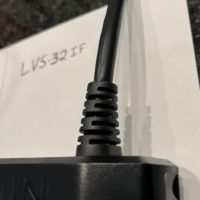Obviously conditions are different in the middle of winter on a frozen lake, but my initial impressions of the new Garmin LVS32-IF Livescope Transducer are as follows:
* I like the single round cable shape vs the original dual side-by-side connected cable shape, there’s zero twisting now..
* The new silicon cable material/coating can better withstand the freezing conditions. It definitely feels alot more pliable, but with that it also feels like it’s a little less durable than the original cable.
* The new round cable is 5/16 thick vs the original cable being thicker at 1/4 x 1/2 thick
* The biggest change by far (and Garmin did start doing this in later production runs of the original LVS32 transducer) is that the cable stress relief/pinch point where it meets the transducer head is markedly better! (No more need for the cable protector add-on)
* I was able to wind the excess transducer cable more easily around the shuttle handle vs the older cable that wanted to constantly twist.
** I wish they reduced the cable length to 10’ or so….the 20’ length is worthless for portable setups, adds extra weight and takes up space inside the case.
To me it’s pretty obvious Garmin received a lot of feedback (and warranty repairs) from customers who used Livescope through the ice (probably something that wasn’t high on their testing plans during the initial Livescope development) so a couple of issues (frozen cable/stress relief) were found and they resolved them with this new LVS32-IF design.
I’ll post another review after I get it on the ice, overall I like it better than the original LVS32 transducer, my only worry would be if I had it installed on a scissors mount trolling motor in the summer months (I personally don’t do this, I use a pole mount) as it would never survive a pitch, but the original cable wouldn’t likely survive it as well so not much of a difference, it’s just a little less forgiving…
I attached a few comparison pictures below…

